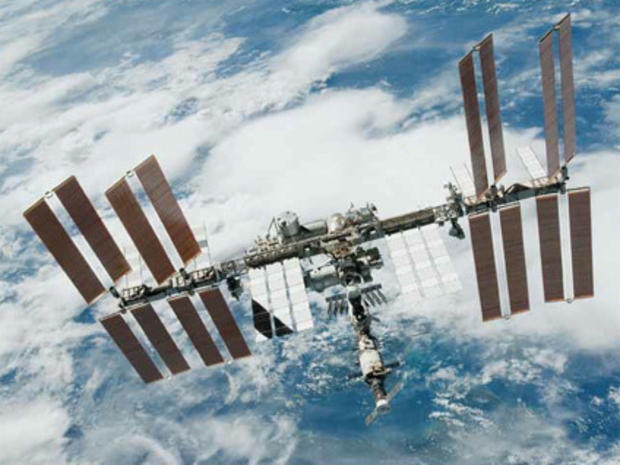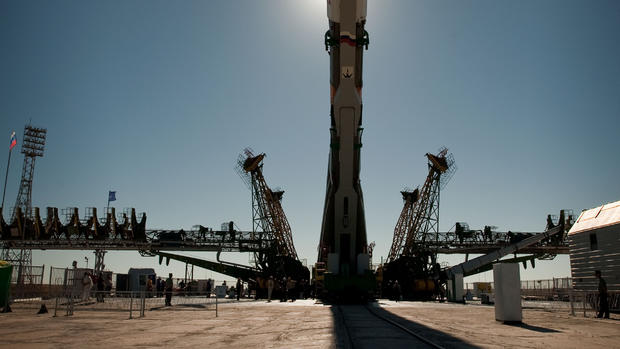Space Station Malfunction Forces Shutdowns
Trouble with one of the International Space Station's external coolant loops, used to dissipate the heat generated by the lab's electronics systems, has triggered extensive equipment powerdowns and troubleshooting, NASA officials said late Saturday. The malfunction occurred around 8 p.m. EDT Saturday, showing up as a short circuit that set off multiple on-board alarms.
It is not yet clear what went wrong, but it involved the pump module in ammonia coolant loop A. The electrical powerdowns affect two of the station's four U.S. control moment gyroscopes, used to help maintain the lab's orientation in space, one communications channel and a variety of computer control boxes known as multiplexer-demultiplexers.
"It seems like we're in a sim right now," flight engineer Tracy Caldwell Dyson joked with ground controllers shortly after 1 a.m. Sunday.
The space station remains in a safe configuration, officials said, while troubleshooting continues. Caldwell Dyson worked through powerdown procedures and moved frozen experiment samples from one freezer to one that uses loop B. She later was joined by Douglas Wheelock, who helped find and install a jumper cable between the Russian Zarya module and the U.S. segment of the station to maintain proper cooling. Flight controllers told Caldwell Dyson the crew could sleep late Sunday while engineers continued assessing the problem.
"We're going to be working hard overnight to figure out what's going on," astronaut James M. Kelly radioed from mission control shortly before the astronauts went back to bed. "By tomorrow, a little bit later on, hopefully we'll be able to send you up a little bit better idea of where we stand on everything."
Shortly before 6 a.m., flight controllers attempted to restart the stalled pump, resetting the circuit breaker that opened late Saturday. Once again, the crew was awakened by alarms.
"Sorry about that. We thought we had (the alarms) taken care of," mission control radioed. "We were trying to turn on the loop alpha pump to see if there was any life in it. Unfortunately, we got a reccurrence of the problem and it shut down. No other actions at this time for you guys, everything else is nominal, we're still in our jumper contingency configuration."
Spare coolant system components, including two pump modules, are on board the station, but it's not yet clear what might be needed to resolve the problem. Wheelock and Caldwell Dyson are scheduled to perform a spacewalk Aug. 5 to mount a robot arm attachment fixture to Zarya and to prepare the station for attachment of a new U.S. storage module in November.
But those plans may change based on the results of the ongoing coolant loop analysis. Replacing a coolant loop pump module is considered a particularly difficult task and likely would require two EVAs to complete.
The space station features two independent coolant loops that use ammonia circulating through huge radiators to dissipate the heat generated by the station's electronic systems. Each loop is fed by a large tank of ammonia that includes an internal bellows pressurized by nitrogen. That pressurization system allows the loops to handle the periodic expansion and contraction of the ammonia coolant due to temperature changes in orbit.
"Losing one of those loops is very significant," space station flight director Brian Smith said before a shuttle flight last November. "We'd lose cooling capability to half of the electronics on the U.S., European and Japanese part of the space station."
The ammonia tank on the left side of the station's power truss, part of coolant loop B, was replaced in August 2009. During a flight by the shuttle Discovery last April, astronauts replaced the tank on the right side in coolant loop A. Other than alignment problems and trouble getting a few bolts to engage, the tank swap went well and there were no indications of any major issues. But flight controllers were unable to re-open the main nitrogen valve needed to re-pressurize coolant loop A.
After Discovery undocked, engineers resolved the problem, cooling the valve and using back pressure to get it open. There have been no other obvious signs of trouble with either coolant loop since then.


